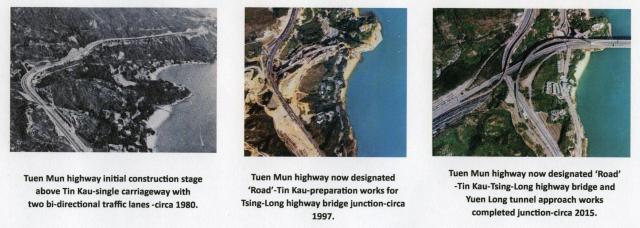When the Tuen Mun Highway was partially opened to traffic it immediately became a chaotic and highly dangerous road.
Many sections were only single carriageways carrying traffic in both directions. Road users frustrated as always, would overtake and undertake vehicles regardless of oncoming traffic. Overloaded and under-powered trucks would crawl slowly up the rising gradients, then speed up regardless of their braking and steering capabilities on the downward slopes. The tolerated convention was slow traffic in the right traffic lane, faster traffic undertakes on the left. There were few access junctions, no safety or refuge lanes for broken down or crashed vehicles to be taken out of the traffic stream.
Container carrying trucks were being introduced in varying states of roadworthiness whose drivers would manage to create slow-moving convoys of such vehicles impossible to pass taking empty containers to the unauthorized storage yards on agricultural lands at the So Kwan Wat valley and the Yuen Long plain.
Disruption to traffic on the highway would see it frequently closed for several hours at a time with traffic then diverting to the equally dangerous old Castle Peak Road, that was invariably flooded with hundreds of suicidal minibuses halting every few hundred yards for passengers demands. Other traffic explored the perils of Route TWISK if they considered their driving capability and vehicle could manage the steep twisting mountain roads, or as a last resort divert via the long route to Tai Po/Fanling and then by country roads to Yuen Long and eventually Tuen Mun.
After travelling on these roads daily for over fifteen years after it opened, and in more recent times by bus on the top deck, front seats. It is a revelation to observe how much the road systems have changed for the better since the Tuen Mun Highway, now called the ‘Tuen Mun Road’ first opened.
